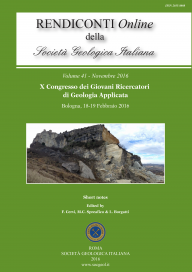
Implementation of DInSAR methods for the monitoring of the archaeological site of Hera Lacinia in Crotone (Southern Italy)
Pierluigi Confuorto (a), Simon Plank (b), Alessandro Novellino (a), Serena Tessitore (a) & Massimo Ramondini (c)
(a) Department of Earth, Environment and Resources Sciences. Federico II University of Napoli, Italy. E-mail: pierluigi.confuorto@unina.it
(b) German Remote Sensing Data Center, Geo-Risks and Civil Security, German Aerospace Center (DLR), Germany
(c) Department of Civil, Architectural and Environmental Engineering, Federico II University of Napoli, Italy
Volume: 41/2016
Pages: 231-234
Abstract
The monitoring of cultural heritage and archeological sites affected by ground deformation is significant for their preservation and protection. The Differential Synthetic Aperture Radar interferometry is here applied to investigate the displacements occurring in the Capo Colonna area (Crotone municipality, Southern Italy), a site whose name derives from the only remaining column of the old Hera Lacinia temple, belonging to the Magna Graecia city of Kroton and dating to the 6th century BC. Processing and interpretation of SAR data has been carried out thanks to the availability of TerraSAR-X images, acquired in the time-span 2008-2010. The results obtained show the protraction of a well-known subsiding trend, connected to a mix of natural (lithostratigraphic setting, seismic activity, eustatic sea-level changes) and anthropogenic causes, the latter represented by the local on-shore and off-shore gas extraction activity. Displacement velocities up to 15 mm/yr have been identified along the satellite Line of Sight (LOS), both in the ascending and in the descending orbits. These two displacement rates have been combined to obtain the vertical component, which has been calculated in 30 mm over two years of monitoring. Moreover, the installation of 80 corner reflectors in October 2014 provided an improvement to the SAR interpretation, allowing not only to further investigate about the relationship between gas extraction and vertical motion but also to focus on the coastal erosion affecting the archeological site.
Keywords
Archaeological sites, coastal erosion, differential SAR interferometry, remote sensing, subsidence, exploitation, SBAS.
Get Full Text